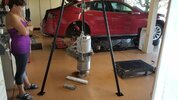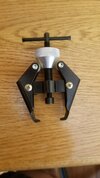danielk04
Member
Okay Mr. Beastie, it sounds like you're looking for tooling information, here you go:Hi Daniel
Thank you for the reply. I am most interested in what you used to R&R the unit, similar to what howard64 has done here. You seem to have a nice setup to R&R these. From howards experience, the motorcycle jack was quite critical to removing the unit safely without damaging anything else. Johan (VanR) has a rav4 and thus the unit comes out much differently than the whole rear subframe on a model S.
Purchased in 2017 and perfect for SAFELY lifting the Model S is the Quickjack 6000ELX. Portable Car Lift - Home Car Lift - BendPak
Next is a nice little Harbor Freight cart to roll under, raise up, then lower the entire subframe assembly. 500 lb. Capacity Hydraulic Table Cart
Now for separating subframe from Drive Unit and manipulating LDU, a hoist. https://www.amazon.com/dp/B00EZQR6D4?psc=1&ref=ppx_yo2ov_dt_b_product_details
Don't forget a modified windshield wiper removal tool for reluctor wheel extraction.


Last edited:


